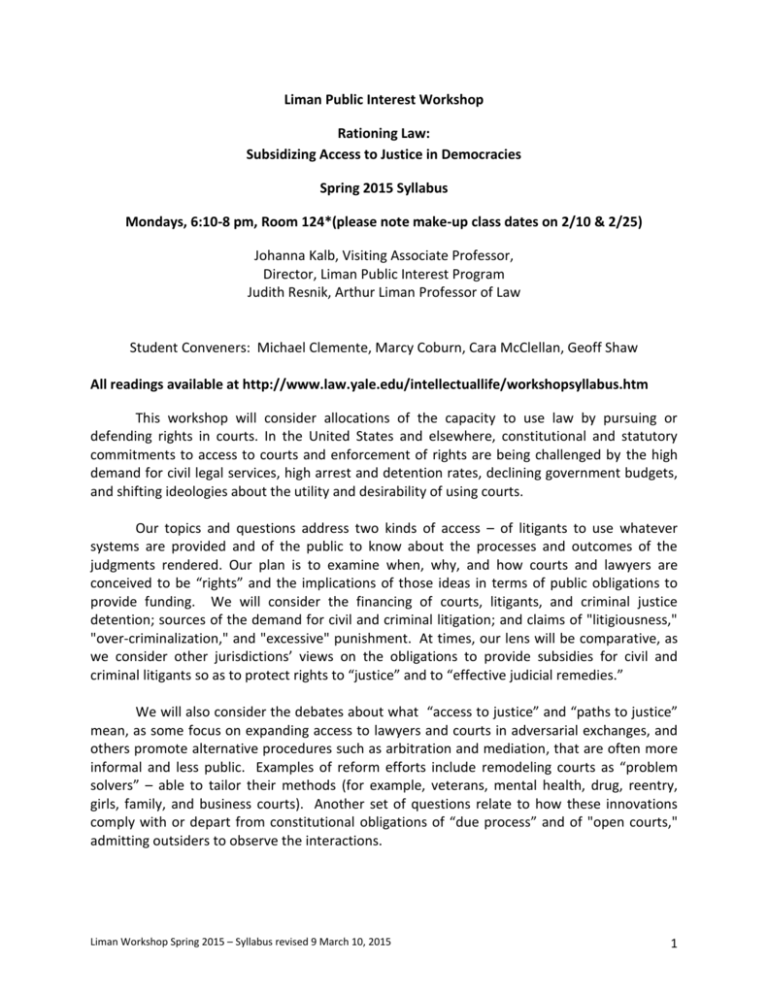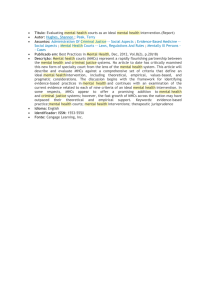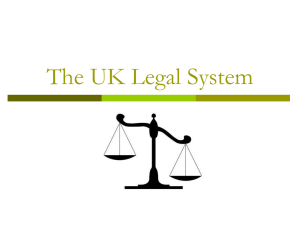Rationing Law
advertisement

Liman Public Interest Workshop Rationing Law: Subsidizing Access to Justice in Democracies Spring 2015 Syllabus Mondays, 6:10-8 pm, Room 124*(please note make-up class dates on 2/10 & 2/25) Johanna Kalb, Visiting Associate Professor, Director, Liman Public Interest Program Judith Resnik, Arthur Liman Professor of Law Student Conveners: Michael Clemente, Marcy Coburn, Cara McClellan, Geoff Shaw All readings available at http://www.law.yale.edu/intellectuallife/workshopsyllabus.htm This workshop will consider allocations of the capacity to use law by pursuing or defending rights in courts. In the United States and elsewhere, constitutional and statutory commitments to access to courts and enforcement of rights are being challenged by the high demand for civil legal services, high arrest and detention rates, declining government budgets, and shifting ideologies about the utility and desirability of using courts. Our topics and questions address two kinds of access – of litigants to use whatever systems are provided and of the public to know about the processes and outcomes of the judgments rendered. Our plan is to examine when, why, and how courts and lawyers are conceived to be “rights” and the implications of those ideas in terms of public obligations to provide funding. We will consider the financing of courts, litigants, and criminal justice detention; sources of the demand for civil and criminal litigation; and claims of "litigiousness," "over-criminalization," and "excessive" punishment. At times, our lens will be comparative, as we consider other jurisdictions’ views on the obligations to provide subsidies for civil and criminal litigants so as to protect rights to “justice” and to “effective judicial remedies.” We will also consider the debates about what “access to justice” and “paths to justice” mean, as some focus on expanding access to lawyers and courts in adversarial exchanges, and others promote alternative procedures such as arbitration and mediation, that are often more informal and less public. Examples of reform efforts include remodeling courts as “problem solvers” – able to tailor their methods (for example, veterans, mental health, drug, reentry, girls, family, and business courts). Another set of questions relate to how these innovations comply with or depart from constitutional obligations of “due process” and of "open courts," admitting outsiders to observe the interactions. Liman Workshop Spring 2015 – Syllabus revised 9 March 10, 2015 1 The readings draw on materials from state and federal, domestic and transnational, civil and criminal, and administrative and judicial proceedings. Throughout, we will look at how social and political movements and race, gender, ethnicity, and class affect our understandings of what constitutes fairness and justice in fashioning systems to respond to claims of injury. Students participating in the Workshop will receive two units of credit. We meet weekly; preparation and attendance at these discussions is required for credit. We have excerpted many of the readings, and we will provide directions in class for which readings are required and which are optional. If you need to miss a class, please be in touch with the professors in advance of the meeting. Students missing more than two sessions without permission will not receive credit. Further, all students participating credit/fail must choose four times during the semester after the first two sessions to submit two-page reflections (double-spaced, size 12 font) that offer comments on that week’s readings. Students must post their reflections on “Inside Yale” NO LATER than 9 a.m. on the Monday mornings of the workshop, and should also circulate them via email to the instructors (judith.resnik@yale.edu and johanna.kalb@yale.edu) as well as to Kathi Lawton (katherine.lawton@yale.edu). Students who do not complete these requirements during the semester will not receive credit for the class. Students who would like graded credit have two options. First, for two graded credits, students may write a responsive essay of no more than 3,000 words during the final examination period. Students who select this option will be provided with specific questions and directions that will require drawing on the course materials and class discussions. Alternatively, if students wish to complete a Supervised Analytic Writing or a Substantial Paper for three graded credits, they need to submit a proposal by the fifth week of the semester and meet with instructors to determine its feasibility and then to agree upon a research plan and schedule. The class may be audited, with permission of the instructor; doing so requires regular attendance. Visitors, again with permission, are also welcome. February 9 (Class 1): Are Courts Rights? This class opens up our discussion by inquiring about the idea of courts as “rights.” What are the sources for that claim? Is there a constitutional obligation that governments provide courts? If so, must all be welcomed? Is the government obliged to fund courts? At what level? Or should courts be understood as a government service for which its users should pay, by way of fees and fines? Further, what about subsidies for users? These many questions will lace the semester. To begin, read the 1971 decision of Boddie v. Connecticut of the U.S. Supreme Court and the 2014 ruling, Trial Lawyers Ass’n of British Columbia v. Att’y Gen. of British Columbia by the Supreme Court of Canada. Also review Article III, and the 5, 6, 7, and 14th Amendments of the U.S. Constitution; copies will be provided in class as well. In addition, review the excerpts provided in these materials from the 1818 Liman Workshop Spring 2015 – Syllabus revised 9 March 10, 2015 2 Connecticut Constitution and the 1819 Alabama Constitution; Articles 5 and 6 of the European Convention on Human Rights (1950), and Articles 47-50 of the Charter of Fundamental Rights of the European Union. Boddie v. Connecticut, 401 U.S. 371 (1971) and related materials, from Cover, Fiss Resnik, Procedure Trial Lawyers Ass’n of British Columbia v. Att’y Gen. of British Columbia, 2014 SCC 59 (Supreme Court of Canada) *This make up class will be held in YLS Faculty Lounge (2nd floor) 7:10-9:00 pm) Tuesday, February 10 (Class 2): When and Why are Lawyers Rights: The Example of Counsel for Criminal Defendants In 1963, the Supreme Court held that defendants facing felony charges must be afforded counsel paid for by the state. In 1966, the Court held that individuals in detention had a right to speak with a lawyer before being questioned. What are the bases for these rulings? Their reach? What issues remained open? What roles were played by race, class, non-domestic law, and federalism? Gabriel J. Chin, Race and the Disappointing Right to Counsel, 122 Yale L. J. 2236 (2013) Gideon v. Wainwright, 372 U.S. 335 (1963) Briefs, excerpted, Gideon v. Cochran, 372 U.S. 355 (1963) (No. 155): Respondent Florida, and Alabama as Amici Curiae Supporting Respondent Miranda v. Arizona, 384 U.S. 436 (1966) Brief on behalf of Petitioner Ernesto A. Miranda, 1966 WL 100543 (Jan. 19, 1966) Brief on behalf of the State of Arizona, 1966 WL 100544 (Feb. 9, 1966) Optional: Alexander Holtzoff, The Right of Counsel under the Sixth Amendment, 20 N.Y.U. L. Q. Rev. 1 (1944) Criminal Defendants’ Rights in Europe Ambrose v. Harris, [2011] UKSC 43 Directive 2013/48/EU of the European Parliament and of the Council of 22 October 2013, on the right of access to a lawyer in criminal proceedings, Art. 1-18. Anna Ogorodova & Taru Spronken, Legal Advice in Police Custody: From Europe to a Local Police Station, European L. Rev. 191 (Dec. 2014) Liman Workshop Spring 2015 – Syllabus revised 9 March 10, 2015 3 February 16 (Class 3): “Effective” Assistance for Criminal Defendants What does the right to counsel mean? Questions include whether the right includes all criminal defendants or only those facing jail terms, when the right “attaches,” and whether it entails a certain level of quality. The issues can emerge before or after trial, and thus another question is whether the right to a lawyer is independent of the outcome achieved by a less than competent lawyer. As you read the case law, consider: How is a lawyer’s performance judged? What monitoring mechanisms exist? What legal rules create incentives and mechanisms to monitor quality? What remedies are appropriate if a lawyer is found to be ineffective? What are the sources of the challenges to fulfill Gideon’s “promise”? What responses are plausible, desirable, and legal? Strickland v. Washington, 466 U.S. 668 (1984) Stephen B. Bright & Sia M. Sanneh, Fifty Years of Defiance and Resistance after Gideon v. Wainwright, 122 Yale L. J. 2150, 2160-2171 (2013) Hurrell-Harring et al., v. State, 15 N.Y.3d 8 (May 6, 2010) Statement of Interest of the United States, filed Sept. 25, 2014 Stipulation and Order of Settlement, Oct. 21, 2014 Darryl K. Brown, Rationing Criminal Defense Entitlements: An Argument from Institutional Design, 104 COLUM. L. REV. 801, 834-35 (2004) Lauren Sudeall Lucas, Lawyering to the Lowest Common Denominator: Strickland’s Potential for Incorporating Underfunded Norms into Legal Doctrine, 5 Faulkner L. Rev. 199 (2014) Optional: Sara Mayeux, Ineffective Assistance of Counsel before Powell v. Alabama: Lessons from History for the Future of the Right to Counsel, 99 Iowa L. Rev. 2161 (2014) February 23 (Class 4): A Right to Counsel in Civil Litigation? Lawyers as Fairness? The U.S. Supreme Court has addressed constitutional claims of civil litigants seeking subsidies when faced with the loss of parental status and with incarceration for failure to pay child support. How do arguments for state subsidies for civil litigants parallel or diverge from the claims made about the right to counsel for criminal defendants? What might fall under the header of “Civil Gideon”? Is the category “civil litigation” useful for analysis or would subcategories be helpful to clarify when governments ought to provide subsidies? Liman Workshop Spring 2015 – Syllabus revised 9 March 10, 2015 4 Lassiter v. North Carolina Dep’t of Social Services, 452 U.S. 18 (1981 ) MLB v. SLJ, 519 U.S. 102 (1996) Turner v. Rogers, 131 S. Ct. 2507 (2011) Order for Contempt of Court, State of South Carolina, County of Oconee, No. 2003-DR-37-472, Jan. 3, 2008 Price v. Turner, 691 S.E.2d 470 (S.C. 2010) Brief on behalf of Petitioner, Brief on behalf of Respondents Brief by amici Benjamin Barton and Darryl Brown in Support of Respondents Jonathan Lippman, State Courts: Enabling Access, DAEDALUS: Journal of the American Academy of Arts & Sciences 28 (Summer, 2014) Optional: Martha F. Davis, Race and Civil Counsel in the United States: A Human Rights Progress Report, 64 SYR. L. REV. 3, 446-467 (2014) Judith Resnik, Fairness in Numbers: A Comment on AT&T v. Concepcion, Wal-Mart v. Dukes, and Turner v. Rogers, 125 HARV. L. REV. 78-94, 97-99, 103-104, 154-161 (2011) *This make up class will be held in YLS Room 121 6:10-8:00 pm) Wednesday, February 25 (Class 5): The Right to an “Effective Judicial Remedy” in Europe Europe has also considered the obligations of governments to provide courts and lawyers. Review Articles 5 and 6 of the European Convention on Human Rights (1950) and Articles 47-50 of the Charter of Fundamental Rights of the European Union, from the first day’s readings. Then review the excerpts of the cases and essays below. How does the U.S. case law overlap or differ from that of the European Court of Human Rights in Airey? What is the relationship of lawyers to “effective” remedies? And what else is required under the idea of the right to an “effective judicial remedy”? What positive obligations flow? And what are the boundaries of these rights? How is the approach of the Inter-American Commission similar or different? Airey v. Ireland, 32 Eur. Ct. H.R. (ser. A) (1979) Excerpts from “Rights to Effective Remedies,” by Dinah Shelton, in The EU Charter of Fundamental Rights: A Commentary, 1209-1228 (2014) Liman Workshop Spring 2015 – Syllabus revised 9 March 10, 2015 5 Valiuline v. Lithuana, app. No. 33234/07, Eur. Ct. H.R. (March 26, 2013) James Gallen, O’Keeffe v. Ireland: The Liability of States for Failure to Provide an Effective System for the Detection and Prevention of Child Sexual Abuse in Education, 78 Modern L. Rev. 151 (2015) Lenahan (Gonzales) v. US, Case 12.626, Inter-Am. Comm’n. H.R., Report No.80/11 (2011) March 2 (Class 6): Mandated Arbitration and Obligatory Mediation In 1925, Congress enacted an arbitration act, known today as the Federal Arbitration Act (FAA) and making enforceable arbitration clauses in contracts. In the mid-1950s, the United States Supreme Court concluded that, when federal statutory rights were in issue, a brokerage customer was not closed out of courts by a form arbitration clause. Within a few decades, the Court reinterpreted the 1925 legislation to require consumers and employees to use arbitration, if specified when goods are purchased or job applications oblige it. The Court based its holdings on the view that arbitrations provide an “effective vindication” of statutory rights. What might be the measures of effective vindication? Consider the European casela, and how do the approaches in the U.S. and Europe vary? Wilko v. Swan, 346 U.S. 427 (1953) AT&T v. Concepcion, 131 S. Ct. 1740 (2011) American Express v. Italian Colors, 133 S. Ct. 2304 (2013) Alassini v. Telecom Italia SpA, C-317/08 ECJ 18 March 2010 Halsey v. Milton Keynes General Trust, NHS, Case No. B3/2003/1458 A.K.C. Koo, Ten Years after Halsey, 34 Civil Justice Quarterly 77 (2015) March 9 (Class 7): Facilitating Prisoners’ Access to Counsel and Courts Prisoners face additional barriers to accessing both courts and counsel. Does the state have the constitutional obligation to help detainees to use courts? What kinds of assistance is required? For what kinds of claims? On what constitutional or other legal grounds? What about the problems for others with distinctive challenges, such as languages and mental or physical abilities? Ex Parte Hull, 312 U.S. 546 (1941) Bounds v. Smith, 430 U.S. 817 (1977) Liman Workshop Spring 2015 – Syllabus revised 9 March 10, 2015 6 Lewis v. Casey, 518 U.S. 343 (1996) Hope Metcalf & Judith Resnik, Gideon at Guantánamo: Democratic and Despotic Detention, 122 Yale L.J. 2504 (2013) Motion for Preliminary Injunction, Orleans Public Defenders v. Marlin Gusman, No. 2011-10638 (March 2012) Nordstrom v. Ryan, 762 F.3d 903 (9th Cir. 2014) Stephanie Clifford, Prosecutors are Reading Emails from Inmates to Lawyers, N.Y. Times, July 22, 2014 [March 16: No Class - Spring Break] March 23 (Class 8): Revenue Sources for Courts: Taxpayers and Users Governments have been a major source of courts’ funding. As demands have risen and as courts face budget shortfalls, many courts have raised user fees for civil litigants and increased civil and criminal fines. As illustrated by Turner v. Rogers, failures to pay can result in various sanctions, including detention for contempt. Thus, decisions by the U.S. Supreme Court in the 1970s and 1980s about the constitutionality of “debtor prisons” have gained new saliency. How should the costs of courts be allocated between taxpayers and users? Should court-based revenues be used exclusively for court services, rendering courts self-supporting? What forms of services are positive entitlements, to be fully supported by the government? Look also at the prices in the fee schedules: What kinds of fees are charged for what kinds of services to what users? What explains the different costs, based on the kinds of legal issues involved? What are the legal bases for imposing fees and fines? For limiting them? Also reflect on the opening discussion of Boddie v. Connecticut and the British Columbia Trial Lawyers litigation. How do those judgments inform these issues? Williams v. Illinois, 399 US 235 (1969) Bearden v. Georgia, 461 U.S. 660 (1983) Ohio Supreme Court Bench Card, Collection of Fines and Court Costs (2014) Brennan Center, Criminal Justice Debt: A Barrier to Reentry 1‐33 (2010) Complaint, Fant et al. v. City of Ferguson, Case No. 4: 15-cv-253 (Feb 8, 2015) Liman Workshop Spring 2015 – Syllabus revised 9 March 10, 2015 7 United States Department of Justice Civil Rights Division, Investigation of the Ferguson Police Department (March 4, 2015) Joseph Shapiro, Alabama Settlement Could be Model for Handling Poor Defendants in Ferguson, Mo., NPR, Nov. 20, 2014 Daniel J. Hall, Reshaping the Face of Justice: The Economic Tsunami Continues, in NATIONAL CENTER FOR THE STATE COURTS, FUTURE TRENDS IN STATE COURTS (2011) Fee Schedules: Circuit Court Fee Schedule, Oregon Judicial Department (2014) Her Majesty’s (HM) Court & Tribunal System, Civil and Family Court Fees (2014) United States v. Kras, 409 U.S. 434 (1973) Michael J. Graetz, Trusting Courts: Redressing the State Court Funding Crisis, DAEDALUS 96 (Summer 2014) Stephen J. Ware, Is Adjudication a Public Good? “Overcrowded Courts” and the Private Sector Alternative of Arbitration, 14 Cardozo J. Conflict Resolution 899 (2013). March 30 (Class 9): “Unnecessary Litigation”: A Critique of Courts A large anti-court movement has formed and had a remarkable impact in terms of rules, statutes, and doctrine in the United States. What is the nature of the critique? What are the empirical claims and how might they be tested? How are the concerns translated into law? Who are the many “defendants” complaining about the system? What are the concerns of the poor defendants in the “junk justice” debt collection mill, and how might they be addressed? U.S. Chamber of Commerce Institute for Legal Reform, Lawsuit Abuse Impact, http://www.instituteforlegalreform.com/issues/lawsuit-abuse-impact. American Tort Reform Association, Judicial Hellholes 2013-14, http://www.judicialhellholes.org/wpcontent/uploads/2013/12/JudicialHellholes2013.pdf Elizabeth G. Thornburg, Judicial Hellholes, Lawsuit Climates, and Bad Social Science: Lessons from West Virginia, 10 W. Va. L. Rev. 1097 (2008) Mayer Brown LLP, Do Class Actions Benefit Class Members?: An Empirical Analysis of Class Actions, http://blogs.reuters.com/alisonfrankel/files/2013/12/mayerbrownclassactionstu dy.pdf Liman Workshop Spring 2015 – Syllabus revised 9 March 10, 2015 8 Peter A. Holland, Junk Justice: A Statistical Analysis of 4,400 Lawsuits Filed by Debt Buyers, 26 Loyola Consumer L. Rev. 179 (2014) Stephen B. Burbank & Sean Farhang, Litigation Reform: An Institutional Approach, 162 U. Penn. L. Rev. 1543 (2014) (SKIM) Optional: Lawyers for Civil Justice, Comment to the Advisory Committee on Civil Rules and its Rule 23 Subcommittee, “Repairing the Disconnect Between Class Actions and Class Members: Why Rules Governing “No Injury” Cases, Certification Standards for Issue Classes, and Notice Need Reform (Aug. 13, 2014). Marc Galanter, An Oil Strike in Hell: Contemporary Legends in the Civil Justice System, 40 Ariz. L. Rev.717 (1998) [April 6: No Class - Liman-Bernstein Colloquium on April 9-10] April 13 (Class 10): The Agency of Lawyers: Contesting and Supplying Resources What can lawyers do when they believe they are not able to represent their clients adequately? How does the structure of the legal market affect the rationing of legal rights and access to justice? What incentives are there for lawyers to provide services? FTC v. Superior Court Trial Lawyers Association, 493 U.S. 411 (1990) State ex rel. Missouri Public Defender Comm’n v. Waters, 370 S.W.3d 592 (2012) Pete Brush, NY The Likely Loser as Strike Pits Lawyer Against Lawyer, May 15, 2013, http://www.law360.com/articles/441776/ny-the-likely-loser-as-strike-pitslawyer-against-lawyer Owen Bowcutt & Nicola Brown, More than 1,000 Lawyers Protest Outside Parliament at Legal Aid Cuts, Mar. 7, 2014, http://www.theguardian.com/law/2014/mar/07/lawyers-protest-parliamentlegal-aid-cuts Erik Eckholm, Public Defenders, Bolstered by a Work Analysis and Rulings, Push Back Against a Tide of Cases, N.Y. TIMES (Feb. 18, 2014) Gillian K. Hadfield, Innovating to Improve Access: Changing the Way Courts Regulate Legal Markets, in DAEDALUS 83 (Summer, 2014) Liman Workshop Spring 2015 – Syllabus revised 9 March 10, 2015 9 Brooks Holland, The Washington State Limited License Technician Practice Rule: A National First in Access to Justice, 82 Miss. L.J. 75 (2013) Melanie Abbott, Leslie C. Levin & Stephen Wizner, Report to the Connecticut Judicial Branch Access to Justice Commission (Feb. 5, 2013) Optional: Stephen Yeazell, Refinancing Civil Litigation, 51 DePaul L. Rev. 183 (2001) April 20 (Class 11): Alternative Courts and Alternatives to Courts: “Drug Courts,” “Girls’ Courts,” “Veterans’ Courts,” and “Mental Health Courts” In the past two decades, “problem-solving courts” have come to the fore. As you read the descriptions, consider the types of claims addressed and the rules. What are the goals of such institutions? Their authority? What roles are there for lawyers? How many subdivided court systems are wise and how much do the targeted populations overlap? Who has access to watch what transpires? What constraints on power are in place? United States v. Leitch, 2013 WL 753445, Nos. 11–CR–00609 (JG), 11–CR–00457 (JG), 11–CR–00039 (JG) (E.D.N.Y. Feb. 28, 2013) Allegra M. McLeod, Decarceration Courts: Possibilities and Perils of a Shifting Criminal Law, 100 Geo. L.J. 1587 (2012) Tamar Lerer, Hawai’i Girls Court: Juveniles, Gender, and Justice, 18 Berkeley J. Crim. L. 1 (2013) Michelle Edgely, Solution-Focused Court Programs for Mentally Impaired Offenders: What Works?, 22 J. Jud. Admin. 208 (2013) E. Lea Johnston, Theorizing Mental Health Courts, 89 Wash. U. L. Rev. 519 (2012) Judge Michael Daly Hawkins, Coming Home: Accommodating the Special Needs of Military Veterans to the Criminal Justice System, 7 OHIO ST. J. CRIM. L. 563 (2010) April 27 (Class 12): “Open and Public Courts” and New Procedural Forms What is the basis of the public’s right to watch court proceedings? Review the state constitutional excerpts from Connecticut and Alabama (class 1) and the relevant portions of the U.S. Constitution. What is the test of what kinds of proceedings are open? The reasons why law insists on openness? Is the view of the need for openness different if adjudication takes place in democratic or non-democratic political regimes? Liman Workshop Spring 2015 – Syllabus revised 9 March 10, 2015 10 Consider also the justifications for closure. Who are the proponents of confidentiality and why? Further, how do mandates for open process apply, or not, to the procedural innovations we have discussed? What impact does openness have on funding of courts and the authority of judges? How do technological changes affect the balance of openness and privacy? Has the understanding of the functions of “publicity” broadened or changed since Bentham’s analysis? Please use these questions to reflect on the themes of the semester. Richmond Newspapers Inc. v. Virginia, 448 U.S. 555 (1980) The Hartford Courant Company v. Pellegrino, 380 F.3d 83 (2d Cir. 2004) N.Y.C.L.U. v. New York City Transit Authority, 684 F.3d 286 (2d Cir. 2011) United States v. Erie County, New York, v. N.Y.C.L.U, 763 F.3d 235 (2d Cir. 2014) Delaware Coalition for Open Government, Inc. v. Strine, 733 F.3d 510 (3d Cir. 2013) Jeremy Bentham, Of Publicity and Privacy, As Applied to Judicature in General, and to the Collection of the Evidence in Particular, in Rationale of Judicial Evidence (1872) Additional Resources Access to Justice Task Forces: http://www.americanbar.org/groups/legal_aid_indigent_defendants/initiatives/ resource_center_for_access_to_justice/state_atj_commissions.html Accessing Justice, Rationing Law (15th annual Liman Colloquium, March, 2012) Rabeea Assy, Injustice in Person: The Right to Self- Representation (forthcoming OUP, 2015) on reserve Legal Services Corporation Act, 42 U.S.C. § 2996e; see also 45 C.F.R. 1611.1, 1611.4 & Appendix A (financial eligibility requirements) Deborah Rhode, Access to Justice (OUP, 2004) Richard Zorza, RICHARD ZORZA’S ACCESS TO JUSTICE BLOG, http://accesstojustice.net/2014/04/04/progress-in-three-states-on-non-lawyeraccess-innovations/ Liman Workshop Spring 2015 – Syllabus revised 9 March 10, 2015 11









